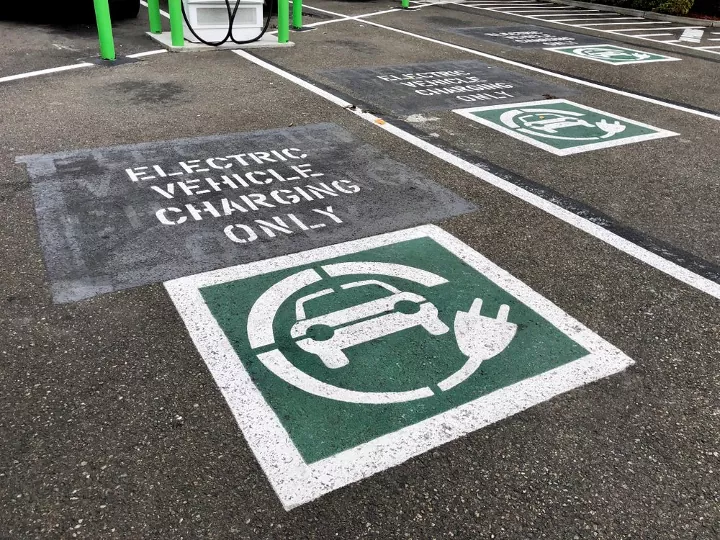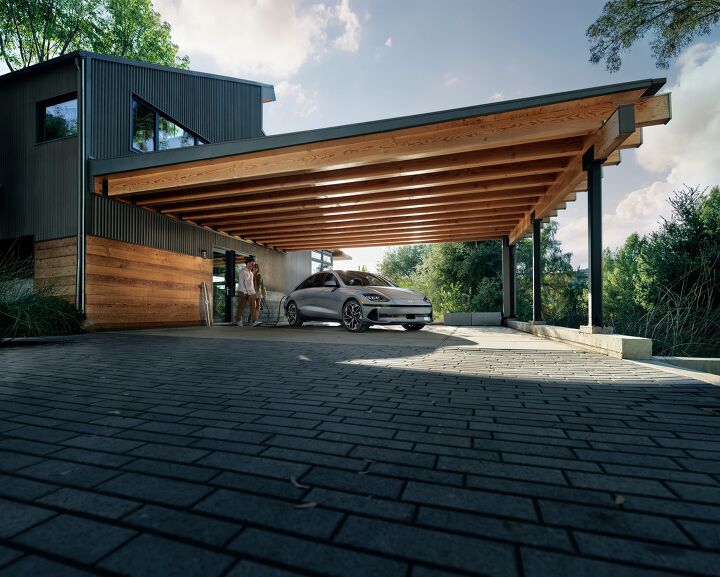Hyundai Offering Free Chargers to EV Buyers, Swelling Industry Incentives

Hyundai is offering customers willing to buy an all-electric vehicle a Level 2 home charger for no extra cost. While the ChargePoint device is framed as being free, it does require the purchase of a new automobile through the automaker’s captive finance arm Hyundai Capital America.
That makes the $33,550 (before any federal tax credits or state incentives) Kona Electric the most affordable way to take advantage of the deal. But you’ll still have to find someone to install the unit into your home, to which the manufacturer has offered a $600 credit toward installation.
That’s unlikely to be enough to actually have the unit set up by an electrician without having to reach into your own pocket. While the price is heavily dependent upon where you live and how your home is set up, the average cost to have a Level 2 charger installed typically ranges between $1,000 and $2,000.
Still, this probably isn’t a bad deal for those already interested in purchasing an EV from Hyundai. But one wonders if it’s enough to pull people away from the mighty Tesla, which continues to dominate the electric car market, and if there won’t be better deals coming in the future.
Despite the EV segment having enjoyed steady growth over the past several years, sales volumes have remained flatter through 2023. Lessened demand may result in manufacturers further incentivizing EV sales, especially as most of them are poised to continue ramping up production to adhere to regulatory requirements the world over.
While this may simply be the result of electric sales reaching peak saturation until technological improvements, emissions regulations or novel designs move the needle forward, Automotive News suggested that economic factors may be playing the largest role here.
From AN:
Cooled demand suggests consumers are still hesitant to make the change. EVs require a high upfront cost compared with gasoline-powered vehicles, and macroeconomic factors such as higher interest rates coupled with tighter lending have sidelined many buyers.
Additionally, the fear of running out of battery energy without access to a charger is perpetuated by the lack of a universal charging infrastructure. Consumers worry about an EV's range and where they might be able to charge on commutes or longer road trips.
Hyundai and some other automakers lost access to a $7,500 federal tax incentive after the Inflation Reduction Act made half the credit dependent on whether an EV's battery is manufactured or assembled in North America and the other half on whether the materials are sourced in the U.S. or from a free-trade agreement partner.
Having done away with the previous quota scheme that capped every automaker at 200,000 vehicles before federal tax incentives ran out opened up the door for indefinite EV subsidization while also prioritizing domestic battery production. But it also took incentives away from a slew of electrified automobiles that would have qualified under the old model. That has undoubtedly played a role in why sales growth seems to be slowing down.
The industry has also had trouble selling EVs down market, with the segment historically catering to more affluent buyers. Making those vehicles more expensive probably isn’t going to help the cause — even if it benefits manufacturers who have managed to localize production inside North America.
With the above in mind, we may continue seeing companies betting big on electrification offering deals like this to help coax people into buying an EV. However, Hyundai’s free deals on chargers only lasts until the end of October and customers have to schedule their at-home installation within 90 days of signing.
“At Hyundai, we are focused on offering a wide range of high-quality EVs for our customers to choose from, but we know that the charging infrastructure and the process of preparing their homes is at the forefront of the minds of many EV-curious buyers,” stated José Muñoz, president and global COO of Hyundai Motor Company and president and CEO of Hyundai Motor North America. “With this offer, we’re making it easier for everyone to go electric by providing our EV customers with an expert Energy Advisor who can personally walk them through the process of outfitting their homes with the proper charging, energy storage and collection equipment using our Hyundai Home Marketplace.”
Hyundai and several other companies have also started offering free charging on through whatever network with whom they enjoy a preexisting relationship. In some instances, this simply results in a few hundred miles worth of range. Other deals are set up to allow customers to have time-based charging “sessions” that may not be enough to fully charge the battery. But most of those can be taken advantage of for a couple of years.
Our advice is to shop around and see what’s out there in terms of perks being offered between manufacturers and models because they vary quite a bit. For example, Nissan will sell you an Ariya with free charging for an entire year while its Leaf only comes with a $100 charging credit. If you’re drawn to any specific models, something like that probably won’t matter anymore than the “free tank of gas” dealerships used to promote. However, if you’re torn between a few, something like that could make all the difference.
It’ll be interesting to see how these incentives progress while the regulatory landscape continues shifting and EV volumes are flatter than in the past.
[Image: Hyundai]

UK Prime Minister Rishi Sunak announced on Wednesday that he’s delaying bans the government had previously made for gasoline-powered vehicles. The scheme was to have the United Kingdom restrict citizens from purchasing new combustion vehicles by 2030. But Sunak has questioned the previous timeline’s viability, opting to push things out to 2035.
This probably isn’t a huge surprise for anyone with at least one foot planted in reality. EV mandates have frequently been accompanied by target dates that are wholly ridiculous. Manufacturers aren’t producing these vehicles in sufficient quantities, the supportive infrastructure isn’t in place, and there's a significant portion of consumers that appear disinterested in buying non-traditional powertrains.
Despite boasting several advantages over their combustion-driven rivals, the downsides of electrification (something which will perhaps be dealt with as the technology continues to improve) are just too much to contend with. Sunak is simply delaying things on those grounds.
"You'll still be able to buy a combustion-engined vehicle until 2035,” he explained, noting that the U.K. just needed more time.
Sunak vowed to keep earlier promises both he and his predecessors have made regarding the reduction of U.K. greenhouse gas emissions to net zero by 2050. But he claimed it required “a more pragmatic, proportionate, and realistic approach.”
That’s probably true. However, one wonders how exactly any of this is being decided. Bans seem to crop up by government proclamation, rather than the popular consensus of its citizens, and often fail to take into account the sweeping logistics involved.. Sunak may be about as appealing as a loaf of damp bread. But he has correctly identified issues with the plan and decided to kick the can down the road for a few ears.
Some have claimed this is being done to boost his political prospects. The United Kingdom has introduced a lot of unpopular ideas of late and the public doesn’t appear to be overjoyed with leadership. EV mandates and restrictive urban planning (e.g. 15-minute cities) have been particularly contentious items elected officials have attempted to walk back in recent months without suggesting they’ll be done away with.
Other issues, like rules banning the installation of natural-gas home furnaces or forcing landlords to modify properties to become more energy efficient by installing smart meters, have also been delayed by a few years by Sunak. However, those fall outside the purview of the automotive world and seemed secondary to his walking back the EV mandates.
"I also think, at least for now, it should be you that makes that choice, not the government forcing you to do it. Because the upfront cost is high. We've got further to go to get the charging infrastructure in place," the PM said, adding that the 2035 deadline was congruent with both the European Union and California.
While corners of the automotive sector have shown support for the government's decision to slow things down (including brands that claimed they’d have fleet-wide electrification years ago), environmental groups and the opposition party are trying to paint Sunak as a Luddite.
Steve Reed, the Labour Party’s Shadow Secretary for the Environment (apparently that’s the actual job title), criticized the decision. He claimed his political allies were wholly committed to adhere to the 2030 combustion ban. Reed also claimed that Sunak had bumbled a largest economic opportunity for the nation this century and “sold out.”
With so many automakers getting sweet deals to manufacture EVs inside the United Kingdom already, it honestly seems like it doesn’t matter whether or not vehicle bans exist. Companies have been making firm commitments regarding electrification, often praising stringent vehicle mandates, before pivoting to support those same regulations being rolled back. Frankly, the whole thing has become a farce and nobody seems worthy of your trust — regardless of which side of the issue you happen to be on.
But let’s get a few more takes just for fun.
The Associated Press made mention that U.K. government “climate advisers” spent June criticizing leadership for being “worryingly slow” on progressing climate goals. It also reportedly bemoaned Sunak’s decision to approve new North Sea oil and gas drilling.
Most of the United Kingdom’s reduction in greenhouse gas emissions have been attributed to the nation moving away from fossil fuels (mainly coal) in electricity generation. But citizens are up in arms about energy prices across the entirety of Europe, with U.K. residents spending last winter discussing the possibility of withholding payments to energy companies in protest. Sunak may be trying to address gaps in energy production that will need to be filled if EVs are to be normalized, catering to voters who are mad about the current status quo, or just throwing a bone to oil and gas companies.
There’s no shortage of theories or people that are divided on the issue.
From AP:
Greenpeace U.K. executive director Will McCallum said Sunak “isn’t offering working people honesty or a brighter future - he’s putting his oil and gas cronies first once again.”
Environmentalists were not the only ones alarmed by the move. Automakers, who have invested heavily in the switch to electric vehicles, expressed frustration at the government’s change of plan.
Ford U.K. head Lisa Brankin said the company had invested 430 million pounds ($530 million) to build electric cars in Britain.
“Our business needs three things from the U.K. government: ambition, commitment and consistency. A relaxation of 2030 would undermine all three,” she said.
Richard Burge, chief executive of the London Chamber of Commerce and Industry, said “the government’s decision to suddenly backtrack and delay the ban on petrol and diesel cars makes us look flaky, unreliable, and incapable of leading the green energy revolution.”
“These changes send a message that nothing is set in stone, and committing in earnest to a movable goalpost could be a major business risk,” Clee said.
Meanwhile, U.K. Conservatives seem to have noticed that the general public doesn’t appear all that excited about the government limiting their purchasing choices or presenting new taxes on vehicles boasting a tailpipe. Adhering to the preexisting climate agenda did them no favors in two special elections held over the summer. However, candidates that bucked the green trend performed significantly better — leading some members of the party to believe that might be the key to winning big in 2024.
Sunak’s approach appears to be more passive. While he noted that second-hand diesel and gasoline-powered vehicles could still be bought and sold after 2035, the plan remains to ban everything but EVs on the new-vehicle market.
However, the government is still considering making exceptions for manufacturers selling fewer than 1,000 vehicles annually. That way extremely rich people can purchase gasoline and diesel powered automobiles while commoners are forced into buying used combustion vehicles and brand-new EVs they may not have wanted in the first place.
[Image: ZikG/Shutterstock]
Become a TTAC insider. Get the latest news, features, TTAC takes, and everything else that gets to the truth about cars first by subscribing to our newsletter.

A staunch consumer advocate tracking industry trends and regulation. Before joining TTAC, Matt spent a decade working for marketing and research firms based in NYC. Clients included several of the world’s largest automakers, global tire brands, and aftermarket part suppliers. Dissatisfied with the corporate world and resentful of having to wear suits everyday, he pivoted to writing about cars. Since then, that man has become an ardent supporter of the right-to-repair movement, been interviewed on the auto industry by national radio broadcasts, driven more rental cars than anyone ever should, participated in amateur rallying events, and received the requisite minimum training as sanctioned by the SCCA. Handy with a wrench, Matt grew up surrounded by Detroit auto workers and managed to get a pizza delivery job before he was legally eligible. He later found himself driving box trucks through Manhattan, guaranteeing future sympathy for actual truckers. He continues to conduct research pertaining to the automotive sector as an independent contractor and has since moved back to his native Michigan, closer to where the cars are born. A contrarian, Matt claims to prefer understeer — stating that front and all-wheel drive vehicles cater best to his driving style.
More by Matt Posky
Latest Car Reviews
Read moreLatest Product Reviews
Read moreRecent Comments
- TheMrFreeze The American auto industry is the last large vestige of our once great industrial power...a nation like ours NEEDS industrial power of this type to survive. Case in point, at the beginning of the pandemic, when PPE and ventilators were desperately needed and our only source was China, it was the US automakers who quickly pivoted to start manufacturing them. No other industry in this country has the skill or manufacturing capabilities to do that.When you take this into consideration, plus the fact that Chinese automakers are financially supported by the CCP while US automakers function as fully free market entities, I have zero problem with a huge tariff being placed on Chinese vehicles to level the playing field. I do think, however, that the government then has the right to "remind" the Big 3 that it's now up to them to provide the affordable vehicles to fill the void the Chinese would have filled.
- Fahrvergnugen Don't knock the Chinese so loudly. They are listening, and reading everything, keeping Naughty and Nice lists.
- Redapple2 2026 f1 cars. Even more crappie! Tune in!F1 is crap. Garbage racing.1 must use 2 types of tires2 cant refuel3 DRS - only in certain places. in certain situations. on certain days of the week. and.... 4 same team wins 90% of races.Go IMSA !!!! or Moto GPPS- Historic Monaco races last weekend were spectacular. All 10 hr on TV.
- Redapple2 volume meets or exceeds expectations......................... But, they always give you high annual volume to quote so they get a cheaper price. You have to tool up to that volume (costing you extra$) because if that part number reaches that volume and you cant meet it? Whao unto you. After getting burned by gm 10 yrs ago, we moved to heavy truck and agriculture products only. Steady volumes. More profits. 30 net payment. The vampire is up to 90-120 days now? Never big 3 work. Ever !
- Tedward I was hypothetically annoyed about this until it happened to my wife. Watching her face twist into disbelieving rage once she realized that gm had sold her data to an insurance company after buying a very nice Cadillac was an eye opener though. If anyone wants a peek at the reputational damage done look at her. GM turned a manual BW purchase (and she's head over heels in love with it) into a non event as far as recos and future purchase considerations go. That's a heavy lift. I mean, she'd buy another manual BW, but there's zero talk about gm cars in general coming from her, in stark contrast to her VW love while she had her gti.

































Comments
Join the conversation
"While this may simply be the result of electric sales reaching peak saturation until technological improvements, emissions regulations or novel designs move the needle forward" You mean until Democrats using their lies about the climate change hoax further sabotage the oil industry forcing us into EVs.
I got a free charger when I bought my first Kia Soul EV in 2016, then was offered another one (I took cash instead) when I traded it in for a 2019 Soul EV.